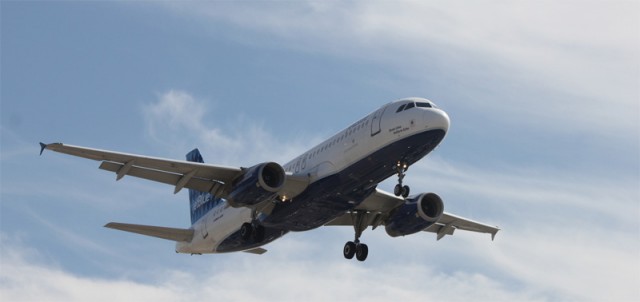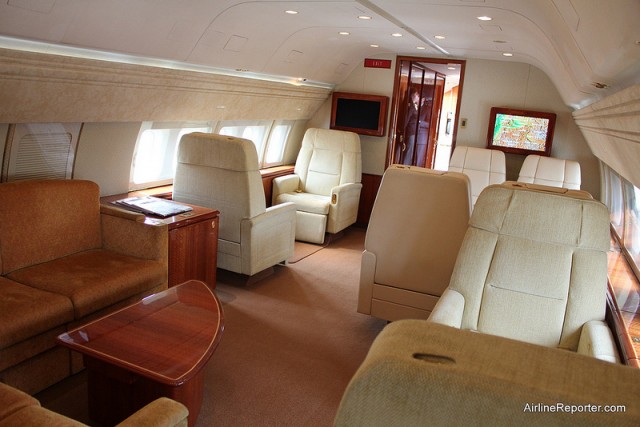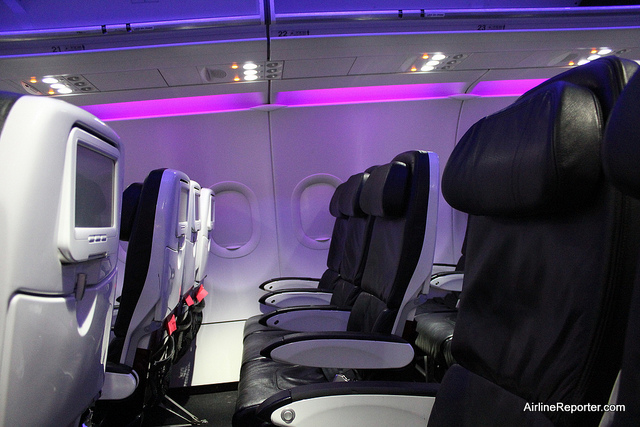
Why can’t we make this JetBlue Airbus A320 a bit wider? Photo: David Parker Brown | AirlineReporter.com
I recently saw a comment on an older AirlineReporter.com post; it referenced a bad experience with a seat being too small. The person posed the following: “If planes were just one foot wider, seats could be as wide as first class. Would that kill Boeing or Airbus?”
I have seen this question come up quite a bit. Sure, for some of you, the answer to this might be pretty obvious. However, I don’t think that the majority of passengers really understand why this seemingly-simple change of adding more room to a plane is not simple at all. And in the end, it is not what passengers really want anyhow.
The data tells us that humans just keep getting bigger – particularly Americans. This is not only from poor diet and lack of exercise, but just how we have evolved as a species. We have easier access to food and healthcare, and as a result are living longer, which in some way connects to us getting taller and wider.
At the same time, airliners are looking to cram as many people into a fuselage as possible in order to maximize efficiency, reduce costs, and maybe squeeze out a profit every quarter or so. These two concepts together certainly have caused passengers to become upset, but are the airlines fully to blame? I think not. I think the majority of the blame lies in the demands of many passengers; they want the cheapest prices possible.
ADDING AN EXTRA FOOT
Let’s first take a look at the initial question of adding an extra foot of width to an airliner. Although it might seem like an easy concept, adding in an extra foot would be quite the undertaking. Let’s say Airbus just decided to slice the A320 down the center and add an extra foot. First off, this would take a good number of years to complete the research, make changes to the assembly process, and start having planes with additional width. A good majority of the plane would likely require a re-design like the wings and landing gear, which are not easy tasks.
The biggest problem is the extra width would be the additional weight, which costs more money for the airlines. The more an airplane weighs, the more fuel it will take getting it from point A to B. At a time where airlines are doing whatever it takes to reduce the weight of an airplane, pound by pound, the cost per seat would surely need to increase to fly the extra foot around the world. And remember, we are adding weight and costs to the plane, but at the same time passengers don’t want to pay more, so who is absorbing that cost? The airlines? They barely make any profit now. Airbus or Boeing? Unlikely.
And let’s be honest here. If an extra foot was added to the width, there would be airlines, like Ryanair, trying to find out how to use that room to add more seats and passengers would be worse off than they were before.

Most passengers would love to fly like this (heck, who wouldn’t). But per passenger, this 737 is not very cost effective.
WIDENING SEATS WITH SAME PLANE WIDTH
Although re-designing an aircraft can be a costly and timely endeavor, just taking out one seat per row or changing a six-abreast aircraft to only five seats would be much easier and give passengers additional space. The problem is we get back to the economics of making that business plan work.
While most mainline domestic carriers offer a product with extra legroom (i.e. United Economy Plus), other international airlines offer passengers an upgraded product, with more legroom and seat-width. Although most people might say they would pay more for extra wiggle room, many of those seats go to mileage plan elite members or those few who are actually willing to pay a bit more.
We are back to space costing most and most passengers, when it comes down to it, are not willing to spend that extra cash.
CONCLUSION
It’s not an easy task for airlines to try and find that sweet spot of providing passengers with enough room and keeping costs low to stay competitive in an extremely competitive market.
Look at the two airlines who are doing the best in the US: Allegiant and Spirit. They both offer almost nothing for free besides a seat to sit on and some oxygen. Any additional space or weight (carry-on bag, food, heck – even water) is going to cost you. Passengers complain about such lack of amenities and space, but the two provide some of the cheapest fares possible and are doing very well financially.
Do not forget, many airlines already offer you the option of having more room; it is called first class. Those seats will provide all that extra room you want (plus better food and service), but of course you will have to pay for it.
Now don’t get me wrong. When I am paying for my flights, I typically will got for the cheapest fare and will rarely pay more for additional room. I also get that we all want our cake and eat it too. But we can’t go and get angry at the airlines for running a business (they aren’t non-profits) and meeting the demands of their customers.
To circle back to the original question of, “would it kill Boeing or Airbus to add an additional foot?” It quite possibly could. If they built a product that would not make an airline money, airlines wouldn’t buy that product and it could substantially hurt an aircraft manufacturer.
If you want airlines to provide more room, then be willing to show them there is a demand – with your wallet. Otherwise, our seats will keep getting smaller.

Respectfully, I would argue this article is a partial view or fallacy. The biggest cost of an airline is fuel. Given the fact that US carriers chose to delay purchase of fuel efficient aircraft, it would be misguided to blame the travelling public for a costly short-term planning decision. The desire to appease investors with quick profit reports has created a self-defeating dynamic. Notice most world carriers have renewed their fleets to avoid sinking money into inefficient fuel burning metal, including your Spirit Air example. Finally, the lack of a vision to improve the customer in-flight experience has pushed the profitable business traveler into the private jet market. Losing big wallet customers means airlines scrambling to make the deficit with ever increasing fees and reduced comfort.
The airlines brought this on themselves with their revenue optimisation. Essentially no two people on the plane pay the same amount, yet they get the same experience. The airlines made it all about money, so passengers made it all about money too. The loyalty programs are virtually worthless, and the airlines don’t seem to realise that the travel experience doesn’t only include the time spent in their seats. It also includes getting to the airport, getting to checkins, “security” screenings, hanging around gates, constant noise and blaring from TVs and loudspeakers, having to deal with staff and other passengers during the boarding process, getting off the plane at the other end and exiting terminals and airports.
When it comes down to it, is there any real difference between the airlines for your journey other than the price?
Fixing it is hard. It requires a sustained track record. It requires transparency and perceived fairness (Southwest is a good example of that). If I was an airline I would make absolutely sure that every traveller knew exactly how much of each ticket they just paid for went to the airport and the government. If every passenger knew they just paid $7 to go through “security” they would be far more demanding that it be fixed.
I would try to do less revenue optimisation. I would encourage people to take photos on the planes and share them on social media. I’d listen real hard for what can be done to improve the whole experience. Customer service would be fixed by removing rules, letting them use discretion more, and realising the goal that people want a pleasant travel experience and try to enable that. I’d put a screen in every seatback, and make it possible to order things easily (some airlines do this, not enough).
Hmmm. So, I’m 6’2, 205 pounds. For me, seat width is not the problem. I’d love some lumbar support, and maybe a headrest that actually stays up. Give me that, and I’m perfectly happy. Widen the cabin a foot? I don’t think that’s the real answer.
Just to throw this out there, I also prefer a widebody on any flight for the higher ceiling and the twin aisles (easier to get to a lav without a bev cart being in the way, plus fast boarding). Asian carriers seem to favor fewer flights with larger airplanes, and I’d love US carriers to swing this way. I remember in the 80s that a PHX-ORD flight meant a 767, not an MD-80.
Oh, and one of the nicest amenities I’ve ever seen (on a Qantas 747 and Asiana 777) was a water fountain so I could fill my bottle any time. So good for long flights.
When I read this post, I thought about how an extra foot of width would affect that most prolific of modern commercial airliners, the venerable and ubiquitous Boeing 737. As you know, that bird’s fuselage makes it first trip by train from Spirit Aero’s plant in Kansas to the narrow-body plant in Renton, Wash. Well, bumping it up a foot would make it’s width 13 feet, 4 inches, according to my very rough calculations. That, in turn, would require special train charges on BNSF Railway (which has had Boeing’s business for years) because anything over 13 feet, 2 inches, is considered an extreme width load.
While BNSF doesn’t share what this would cost publicly (it’d cut a deal with Boeing anyway), competitor Union Pacific does on its website. Here’s the damage: “Special Train charges apply to any excessive dimensional shipment. Customers will pay special train charges of $120/rail mile, with a minimum charge of $24,000, in addition to regular freight charges.”
In other words, it’d cost lots more money for a new 737 were it just a foot wider…
So, 2500 miles at $120/mile is $300K. Assuming 1 airplane per train (bad assumption, but just go with it) that means a 737-800 will go from 93.3M to 93.6M at list prices. A price increase of 0.3%.
To put that in perspective, if you pay $3 a gallon for gas, that increase would mean you now pay almost a penny more.
Wow, X, it took ya a year to figure that out? I thought my math skills were bad! Seriously, though, you are correct: the extra fees would be chump change to BCA…just a paltry $12.6 million annually, since the current production rate is 42 a month (that’ll go up to 52 a month in in ’18).
Still, airframers operate in some ways like utilities; they can make a penny squeak! Not only will rail charges increase, but everything at Renton will have to be dimensionally altered, too, from the dragsters used to cart the fuselages from the unloading bay to the jigs on the moving line. All that’ll add up!
In terms of economy space and comfort, knowledgeable passengers usually look at ‘seat pitch’ as the measure. But the trend to putting 10 economy seats across in the 777 versus 9 across makes these planes seriously uncomfortable. 747s are 10 across in a much wider cabin. Glad to see Singapore is not going for the 10 across 777 layout. Air NZ does this as do many carriers, even Emirates. In a middle seat you can’t even lift your arms to eat your meal. An aisle seat means your shoulder sticks out and gets bashed every time anyone walks by because the aisles are ridiculously narrow. I now avoid 10 across 777 economy flights entirely. Is anyone else finding this an issue? I’d love to see an analysis of what gets narrowed in a 10 across 777 vs 747. Arm rest? Aisle? Seat?
I think airlines should start to take the Economy Plus/Premium Economy concept seriously. For a 10-20% extra charge I believe there are significant travelers willing to upgrade if there is an added space and width.
I am 5’4″, 125 lbs and I found the distance between my forehead and the seat in front of me to be so close it gave me claustrophobia. But it also inspired a new ad campaign I’d like to share with Mr. Alan Joyce, CEO of Qantas. Why don’t you just have a “Rack em and Stack em” section, I’m sure that would up your quarterly revenues to an all time high. I am appalled by the expectation that even one human being in this day and age should be subjected to such conditions for 15 hours straight. And I have never been told by a flight attendant to shut my window shade. Ever. Two and a half hours into the flight all I had been offered was a token bottle of water. Pathetic. When will human value and dignity be calculated into your bottom line Mr. Joyce or that of your board of directors?? Air New Zealand still offer hot face washers and twice the distance between seats. Please rethink your level of customer service. As far as seating goes, it’s non-existent. As for your coffee, why bother. Your YTD performance isn’t looking too good. Improve your seating space and serve real coffee (and food). That would go a long way in improving public image and restoring my faith in humanity.
Jane, Now imagine that same scenario with someone who is 6’5″ tall and 250#. I nearly cried during a UAL flight from FRA to SFO as my knees hurt so badly from being jammed into the seat in front of me and that was before it was reclined. My legs went numb about 8 hours in and I was seriously in fear of developing deep vein thrombosis. Every time I tried to walk around I got the stink-eye from flight attendants. I can only imagine how much grief I would have received had I been near the flight deck.
I’d be just fine without a warm towel; all I ask is a reasonable amount of legroom.